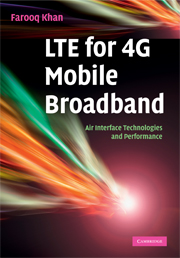Book contents
- Frontmatter
- Contents
- Preface
- 1 Introduction
- 2 Network architecture and protocols
- 3 Downlink access
- 4 Single-carrier FDMA
- 5 Reducing uplink signal peakiness
- 6 Transmit diversity
- 7 MIMO spatial multiplexing
- 8 Channel structure and bandwidths
- 9 Cell search and reference signals
- 10 Random access
- 11 Channel coding
- 12 Scheduling, link adaptation and hybrid ARQ
- 13 Power control
- 14 Uplink control signaling
- 15 Downlink control signaling
- 16 Inter-cell interference control
- 17 Single frequency network broadcast
- 18 Spatial channel model
- 19 LTE performance verification
- Index
7 - MIMO spatial multiplexing
Published online by Cambridge University Press: 28 February 2011
- Frontmatter
- Contents
- Preface
- 1 Introduction
- 2 Network architecture and protocols
- 3 Downlink access
- 4 Single-carrier FDMA
- 5 Reducing uplink signal peakiness
- 6 Transmit diversity
- 7 MIMO spatial multiplexing
- 8 Channel structure and bandwidths
- 9 Cell search and reference signals
- 10 Random access
- 11 Channel coding
- 12 Scheduling, link adaptation and hybrid ARQ
- 13 Power control
- 14 Uplink control signaling
- 15 Downlink control signaling
- 16 Inter-cell interference control
- 17 Single frequency network broadcast
- 18 Spatial channel model
- 19 LTE performance verification
- Index
Summary
In the previous chapter, we discussed how multiple transmission antennas can be used to achieve the diversity gain. The transmission diversity allows us to improve the link performance when the channel quality cannot be tracked at the transmitter which is the case for high mobility UEs. The transmission diversity is also useful for delay-sensitive services that cannot afford the delays introduced by channel-sensitive scheduling. The transmission diversity, however, does not help in improving the peak data rates as a single data stream is always transmitted. The multiple transmission antennas at the eNB in combination with multiple receiver antennas at the UE can be used to achieve higher peak data rates by enabling multiple data stream transmissions between the eNB and the UE by using MIMO (multiple input multiple output) spatial multiplexing. Therefore, in addition to larger bandwidths and high-order modulations, MIMO spatial multiplexing is used in the LTE system to achieve the peak data rate targets. The MIMO spatial multiplexing also provides improvement in cell capacity and throughput as UEs with good channel conditions can benefit from multiple streams transmissions. Similarly, the weak UEs in the system benefit from beam-forming gains provided by precoding signals transmitted from multiple transmission antennas.
MIMO capacity
A MIMO channel consists of channel gains and phase information for links from each of the transmission antennas to each of the receive antennas as shown in Figure 7.1.
- Type
- Chapter
- Information
- LTE for 4G Mobile BroadbandAir Interface Technologies and Performance, pp. 147 - 171Publisher: Cambridge University PressPrint publication year: 2009



